Henry Moore and Tate: A Timeline
1921
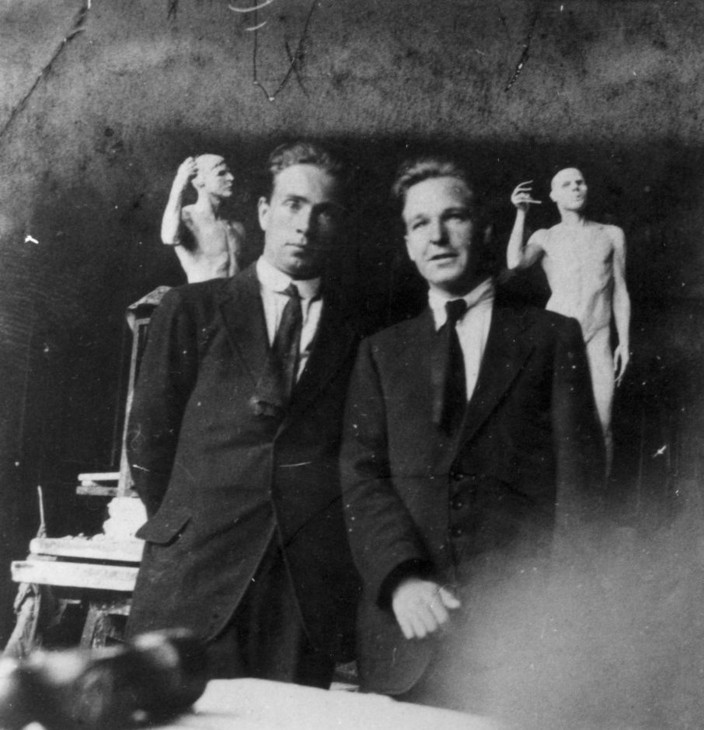
Raymond Coxon and Henry Moore standing in front of clay figures they had made, Leeds School of Art, summer 1921
Tate Archive
© The Henry Moore Foundation. All rights reserved
Raymond Coxon and Henry Moore standing in front of clay figures they had made, Leeds School of Art, summer 1921
Tate Archive
© The Henry Moore Foundation. All rights reserved
1933
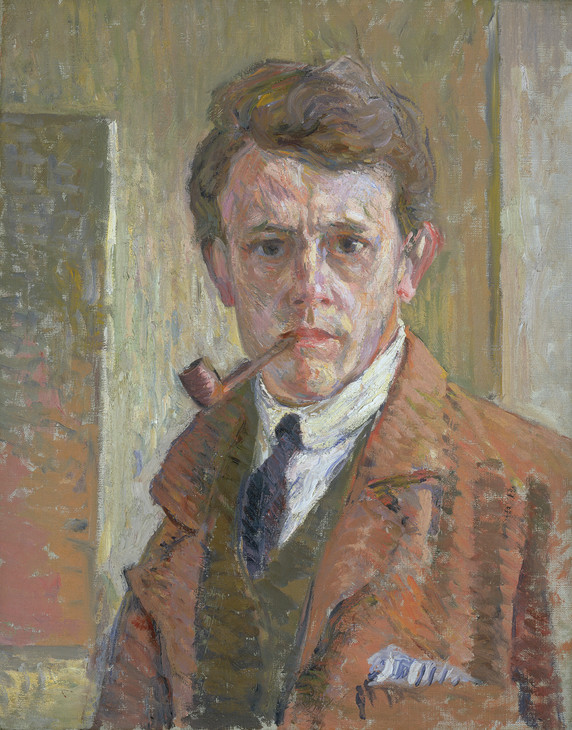
James Bolivar Manson 1879–1945
Self-Portrait c.1912
Oil paint on canvas
support: 508 x 397 mm
Tate N04929
Presented by D.C. Fincham 1938
© Tate
James Bolivar Manson
Self-Portrait c.1912
Tate N04929
© Tate
1938
J.B. Manson tells Tate Trustee Robert Sainsbury, ‘Over my dead body will Henry Moore ever enter the Tate’.3 Manson is succeeded by John Rothenstein later in the year.
1939
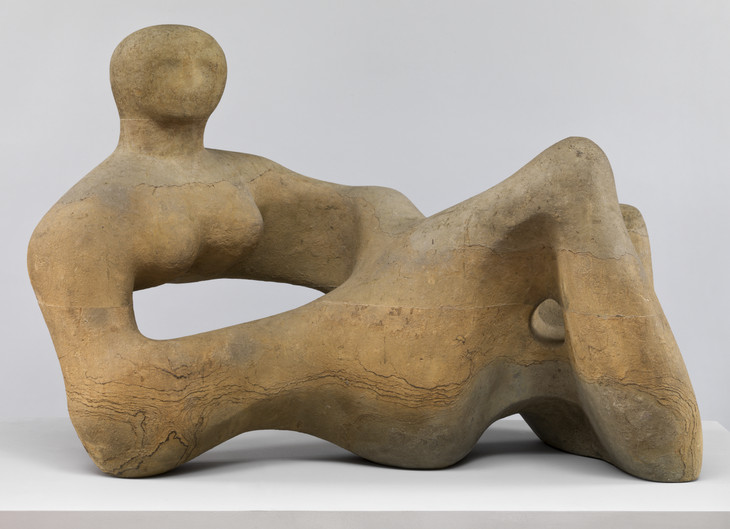
Henry Moore OM, CH 1898–1986
Recumbent Figure 1938
Green Hornton stone
object: 889 x 1327 x 737 mm, 520 kg
Tate N05387
Presented by the Contemporary Art Society 1939
© The Henry Moore Foundation. All Rights Reserved
Henry Moore OM, CH
Recumbent Figure 1938
Tate N05387
© The Henry Moore Foundation. All Rights Reserved
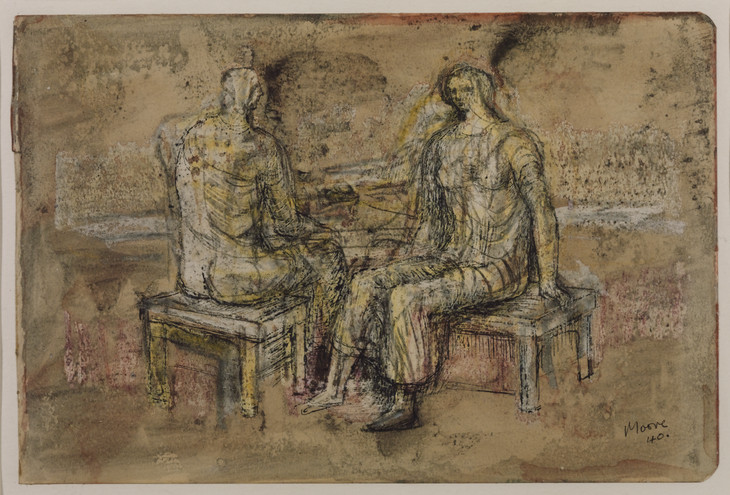
Henry Moore OM, CH 1898–1986
Two Seated Figures 1940
Watercolour, gouache, chalk and ink on paper
support: 181 x 270 mm; frame: 399 x 491 x 15 mm
Tate N05208
Purchased 1940
© The Henry Moore Foundation. All Rights Reserved
Henry Moore OM, CH
Two Seated Figures 1940
Tate N05208
© The Henry Moore Foundation. All Rights Reserved
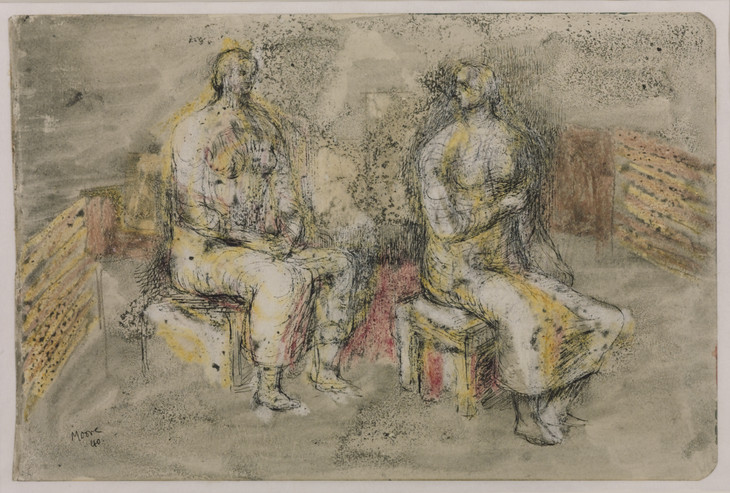
Henry Moore OM, CH 1898–1986
Two Seated Women 1940
Watercolour, gouache, chalk and ink on paper
support: 181 x 270 mm
Tate N05209
Purchased 1940
© The Henry Moore Foundation. All Rights Reserved
Henry Moore OM, CH
Two Seated Women 1940
Tate N05209
© The Henry Moore Foundation. All Rights Reserved
1940
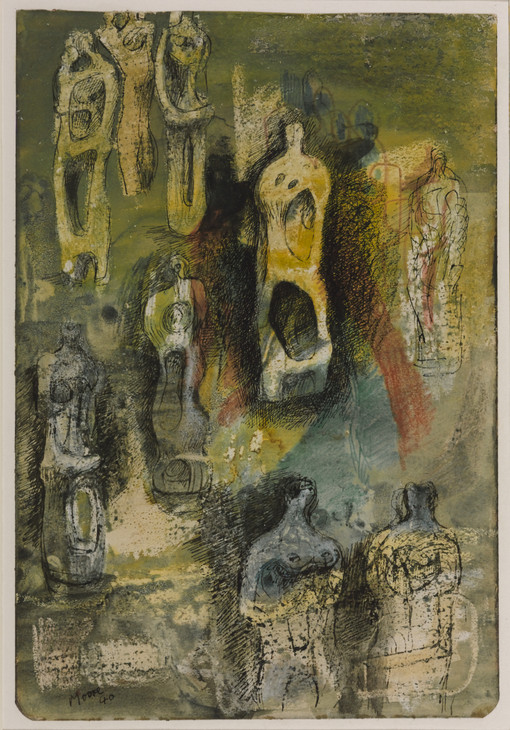
Henry Moore OM, CH 1898–1986
Standing Figures 1940
Wax, coloured pencil, graphite, ink and watercolour on paper
support: 264 x 181 mm; frame: 490 x 400 x 17 mm
Tate N05210
Purchased 1940
© The Henry Moore Foundation. All Rights Reserved
Henry Moore OM, CH
Standing Figures 1940
Tate N05210
© The Henry Moore Foundation. All Rights Reserved
1941
Moore is appointed to the board of Trustees.
Moore is appointed to the board of Trustees.
1944
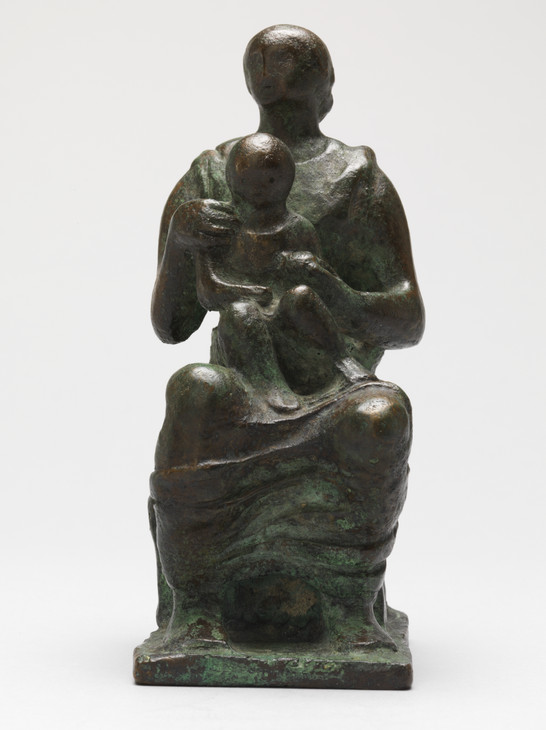
Henry Moore OM, CH 1898–1986
Maquette for Madonna and Child 1943, cast 1944–5
Bronze
object: 156 x 86 x 70 mm
Tate N05602
Purchased 1945
© The Henry Moore Foundation. All Rights Reserved
Henry Moore OM, CH
Maquette for Madonna and Child 1943, cast 1944–5
Tate N05602
© The Henry Moore Foundation. All Rights Reserved
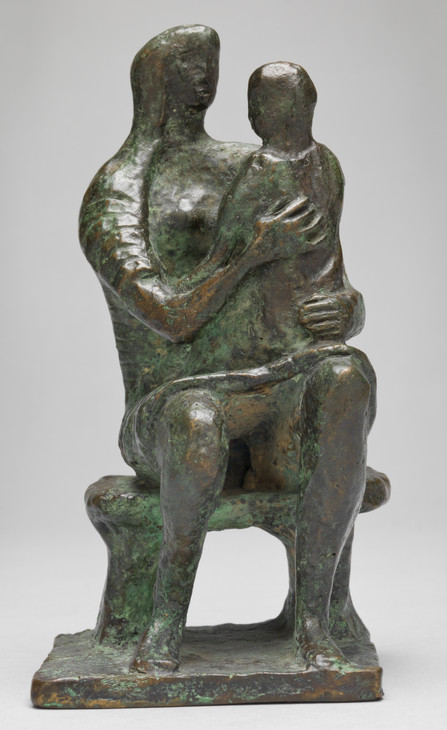
Henry Moore OM, CH 1898–1986
Maquette for Madonna and Child 1943, cast 1944–5
Bronze
object: 140 x 76 x 76 mm
Tate N05600
Purchased 1945
© The Henry Moore Foundation. All Rights Reserved
Henry Moore OM, CH
Maquette for Madonna and Child 1943, cast 1944–5
Tate N05600
© The Henry Moore Foundation. All Rights Reserved
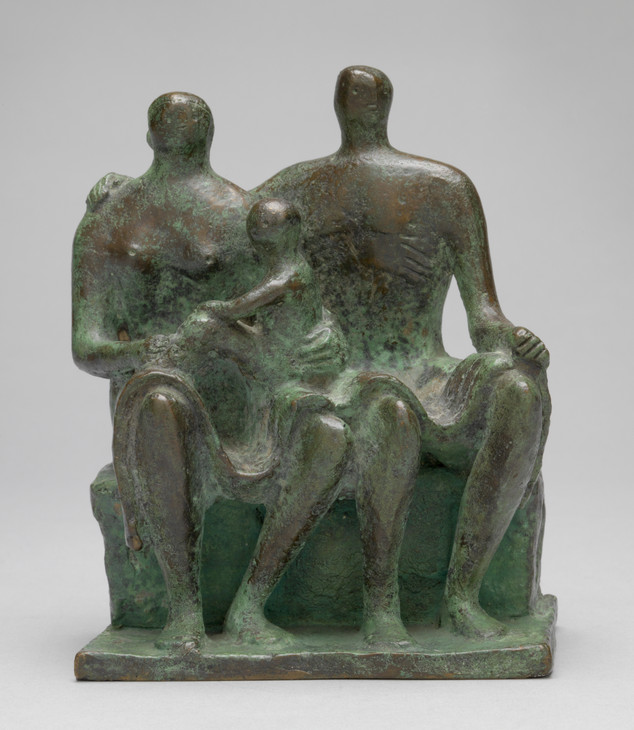
Henry Moore OM, CH 1898–1986
Maquette for Family Group 1943, cast 1944¿5
Bronze
object: 137 x 114 x 67 mm
Tate N05604
Purchased 1945
© The Henry Moore Foundation. All Rights Reserved
Henry Moore OM, CH
Maquette for Family Group 1943, cast 1944¿5
Tate N05604
© The Henry Moore Foundation. All Rights Reserved
1945
In April the Tate Gallery purchases four bronze Madonna and Child maquettes (N05600–N05603) and three bronze maquettes for Family Group (N05604–N05606).
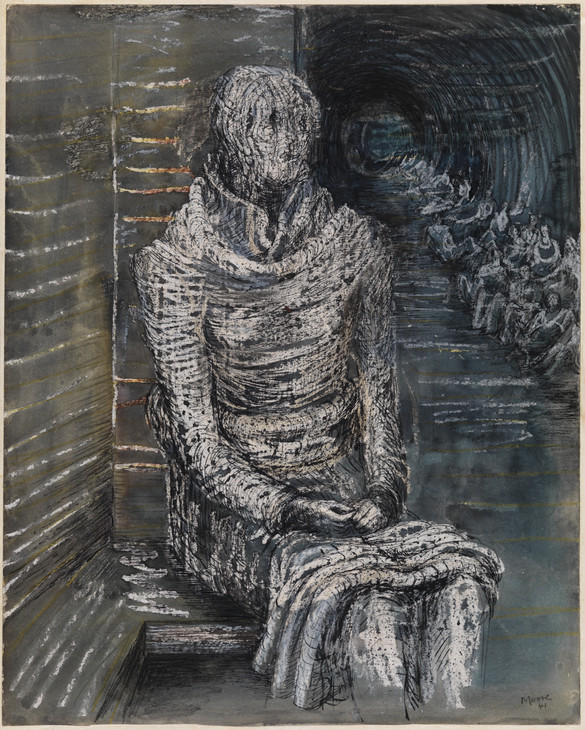
Henry Moore OM, CH 1898–1986
Woman Seated in the Underground 1941
Gouache, ink, watercolour and crayon on paper
support: 483 x 381 mm
Tate N05707
Presented by the War Artists Advisory Committee 1946
Henry Moore OM, CH
Woman Seated in the Underground 1941
Tate N05707
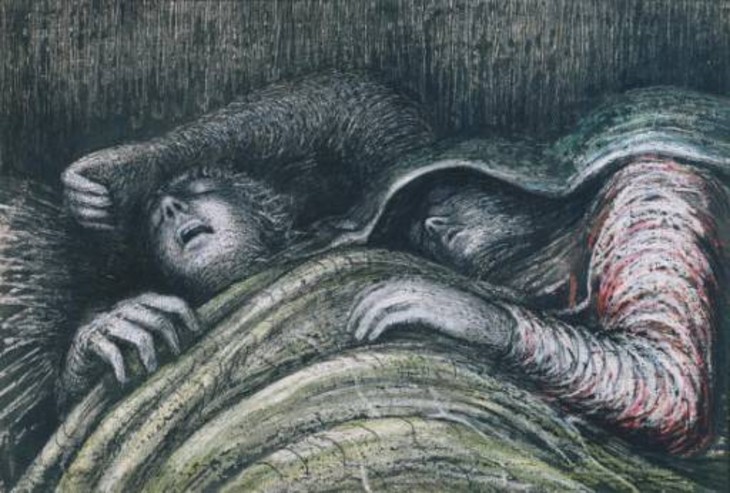
Henry Moore
Pink and Green Sleepers 1941
Tate N05713
© The Henry Moore Foundation. All Rights Reserved
Henry Moore
Pink and Green Sleepers 1941
Tate N05713
© The Henry Moore Foundation. All Rights Reserved
1946
Eight of Moore’s ‘Shelter Drawings’, including Woman Seated in the Underground 1941 and Pink and Green Sleepers 1941, are presented to Tate by the War Artists Advisory Committee (Tate N05706–N05713).
1948
Moore’s term as Trustee of the Tate Gallery comes to an end. Of his term of service Sir Jasper Ridley, Chairman of the Tate Trustees, later noted, ‘Henry Moore was a conspicuously useful Trustee on any topic that arose, whether in judgement or administration’.5
1949
On 12 July Anthony Bevir, the Permanent Secretary to the Prime Minister’s Office, writes to Moore saying, ‘There is a vacancy on the Board of the Tate Gallery, and the Prime Minister has asked me to enquire whether you would be prepared to serve as a Trustee’.6 Moore accepts the post and serves as a Trustee until 1956.
1951
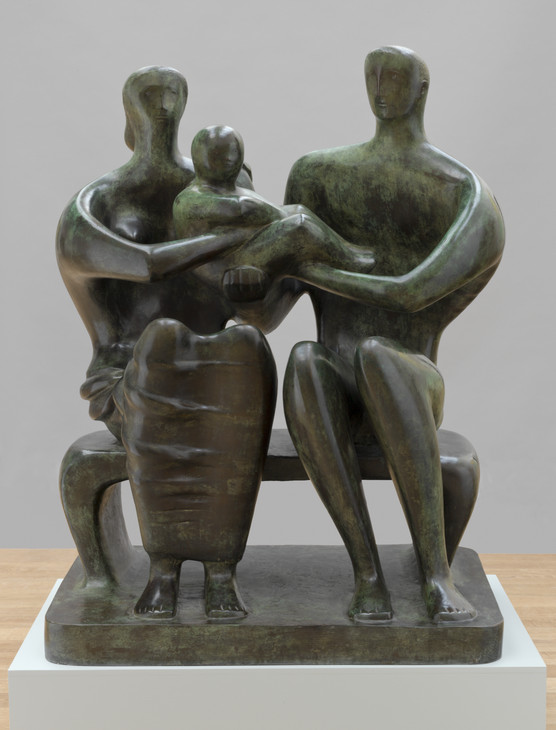
Henry Moore OM, CH 1898–1986
Family Group 1949, cast 1950–1
Bronze
object: 1540 x 1180 x 700 mm, 475 kg
Tate N06004
Purchased 1950
© The Henry Moore Foundation. All Rights Reserved
Henry Moore OM, CH
Family Group 1949, cast 1950–1
Tate N06004
© The Henry Moore Foundation. All Rights Reserved
1951
Moore’s first solo exhibition at the Tate Gallery takes place between May and July at the same time as the Festival of Britain exhibition on London’s South Bank. Sculpture and Drawings by Henry Moore is curated by David Sylvester.
1952
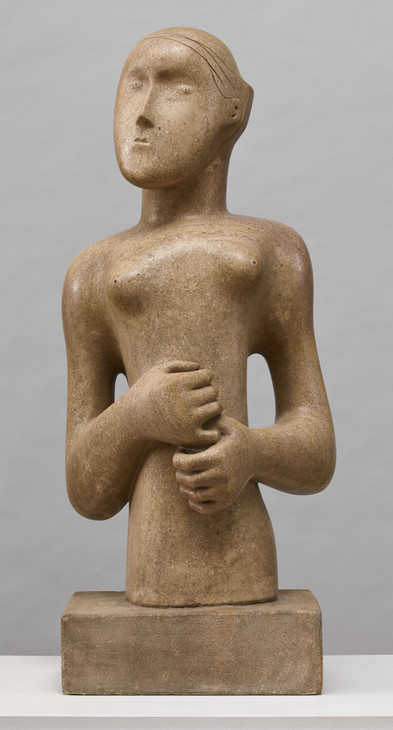
Henry Moore OM, CH 1898–1986
Girl 1931
Ancaster stone
object: 737 x 368 x 273 mm
Tate N06078
Purchased 1952
© The Henry Moore Foundation. All Rights Reserved
Henry Moore OM, CH
Girl 1931
Tate N06078
© The Henry Moore Foundation. All Rights Reserved
The Tate Gallery purchases Girl 1931 (Tate N06078) from the Whitechapel Art Gallery, London, in July. It is the first carving by Moore purchased by Tate (Recumbent Figure was a gift).
1957
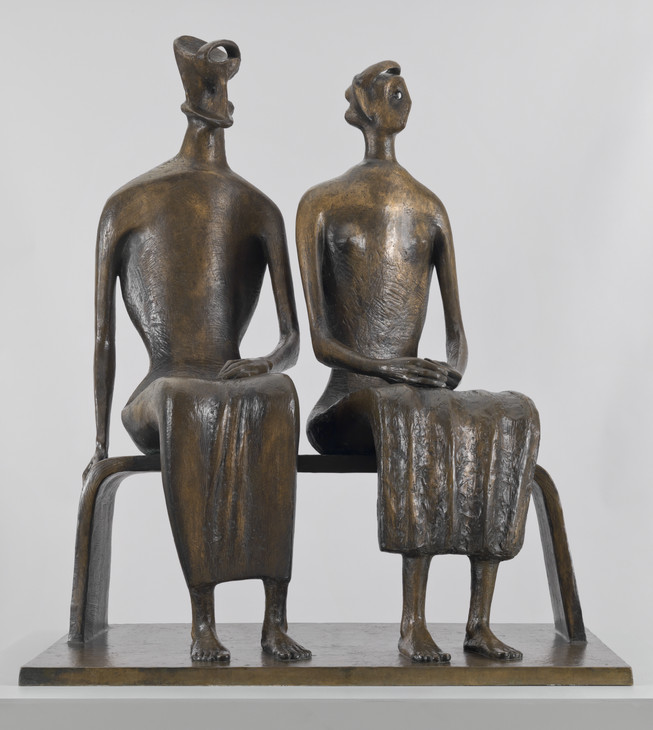
Henry Moore OM, CH 1898–1986
King and Queen 1952–3, cast 1957
Bronze
object: 1640 x 1390 x 910 mm
Tate T00228
Presented by the Friends of the Tate Gallery with funds provided by Associated Rediffusion Ltd 1959
© The Henry Moore Foundation. All Rights Reserved
Henry Moore OM, CH
King and Queen 1952–3, cast 1957
Tate T00228
© The Henry Moore Foundation. All Rights Reserved
On the 16 May Tate’s Trustees approve the proposal to acquire King and Queen 1952–3 (Tate T00228). According to the minutes of the meeting, ‘the Director emphasised the extreme generosity and helpfulness of the sculptor’s attitude in making works available from his own collection for sums substantially below their market value ... and for agreeing to seek the approval of the authorities of the City of Antwerp for making an extra cast of King and Queen’.7 Moore cast an example of King and Queen for the Tate Gallery in June 1957, which was acquired in the following year with support from Associated Rediffusion, the first independent commercial television company in the London region.
1959
On 4 February King and Queen is placed on display for the first time.
1959
The publisher and collector E.C. Gregory dies and names the Tate Gallery as a beneficiary in his will. Given the first choice of Gregory’s collection, the Trustees select two sculptures by Moore, Figure 1931 (Tate T00240) and Half-Figure 1932 (Tate T00241), and one work each by Jean Arp (Tate T00242), Jean Dubuffet (Tate T00243), Louis Marcoussis (Tate T00244) and Vieira da Silva (Tate T00245). The gallery is also able to purchase a further twelve works prior to the sale of remaining items at auction. Moore is asked to draw up a list of appropriate purchases and in a letter dated 29 May John Rothenstein thanks the sculptor and notes that, ‘having richly earned a period of honourable retirement you are being just as much involved in the Gallery’s affairs as you were when you were a Trustee’.8
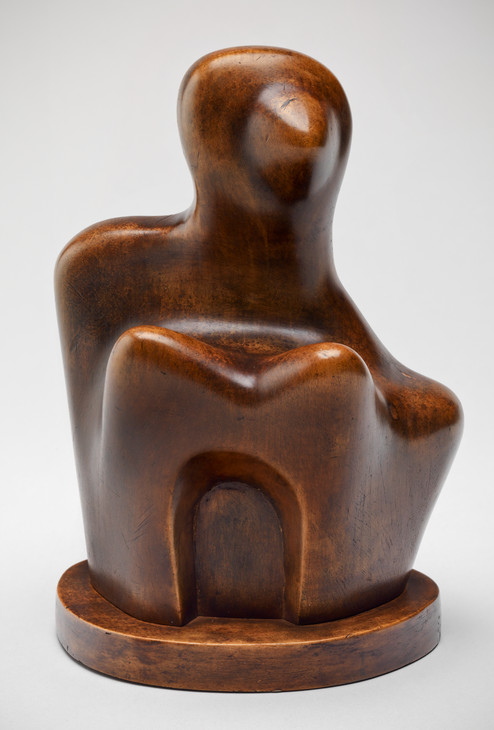
Henry Moore OM, CH 1898–1986
Figure 1931
Beech
object: 248 x 178 x 121 mm
Tate T00240
Purchased 1959
© The Henry Moore Foundation. All Rights Reserved
Henry Moore OM, CH
Figure 1931
Tate T00240
© The Henry Moore Foundation. All Rights Reserved
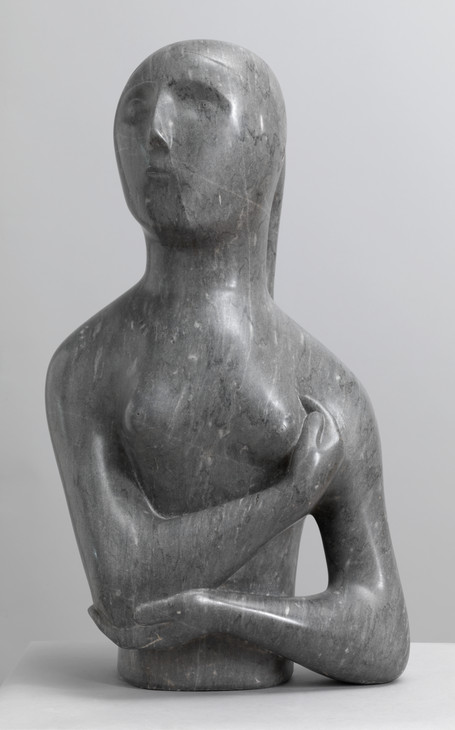
Henry Moore OM, CH 1898–1986
Half-Figure 1932
Armenian marble
object: 686 x 381 x 279 mm
Tate T00241
Bequeathed by E.C. Gregory 1959
© The Henry Moore Foundation. All Rights Reserved
Henry Moore OM, CH
Half-Figure 1932
Tate T00241
© The Henry Moore Foundation. All Rights Reserved
1960
Following negotiations with Moore carried out over the course of the previous three years, the Friends of Tate acquire six sculptures by Moore: Composition 1932 (T00385); Stringed Figure 1938/60 (T00386); Reclining Figure 1939 (T00387); Helmet Head No.1 1950 (T00388); Mother and Child 1953 (T00389); and Working Model for Unesco Reclining Figure 1957 (T00390). The sculptures are acquired directly from the artist and are seen as representative examples of Moore’s styles and subjects to date.
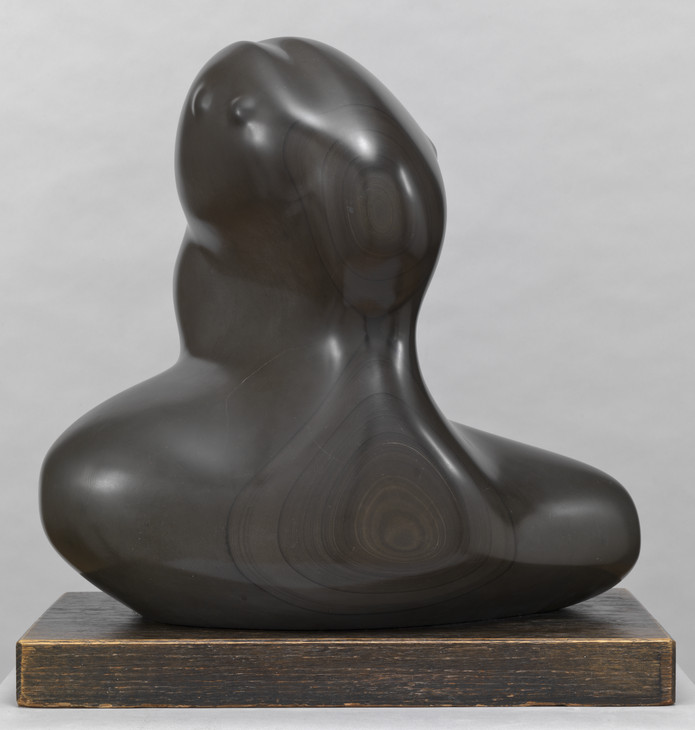
Henry Moore OM, CH 1898–1986
Composition 1932
African wonderstone on oakwood base
object: 445 x 457 x 298 mm
Tate T00385
Presented by the Friends of the Tate Gallery 1960
© The Henry Moore Foundation. All Rights Reserved
Henry Moore OM, CH
Composition 1932
Tate T00385
© The Henry Moore Foundation. All Rights Reserved
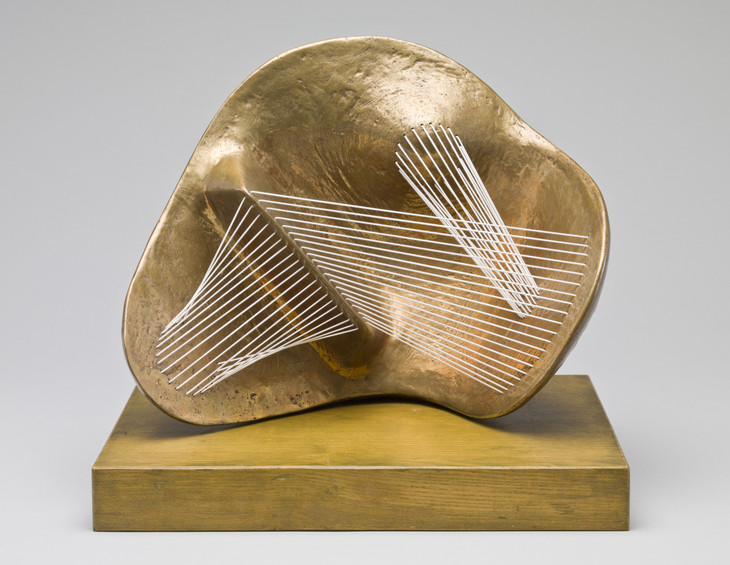
Henry Moore OM, CH 1898–1986
Stringed Figure 1938, cast 1960
Bronze and elastic string
object: 273 x 343 x 197 mm
Tate T00386
Presented by the Friends of the Tate Gallery 1960
© The Henry Moore Foundation. All Rights Reserved
Henry Moore OM, CH
Stringed Figure 1938, cast 1960
Tate T00386
© The Henry Moore Foundation. All Rights Reserved
1964
On Tuesday, 15 September, Moore and John Rothenstein meet to discuss Moore’s idea of a major gift of his sculpture to the Tate Gallery. On 18 September Rothenstein writes to Moore: ‘yesterday I reported to the Board in accordance with our agreement on Tuesday, your intention of making a bequest of a number of your works to the gallery’.9 In late 1964 Rothenstein steps down from his post as Director of the Tate Gallery and is succeeded by Norman Reid.
1967
On 27 February Moore’s intention to give the Tate Gallery a selection of his work is announced in the press. A report of ‘The Henry Moore Gift’ is published on the front page of the Times. In May a letter protesting against Moore’s Gift and signed by prominent young artists and art school tutors is published in the Times.
1968
Moore’s second retrospective exhibition at Tate Gallery is held between July and September. Curated by David Sylvester, the exhibition marks the artist’s seventieth birthday.
1969
In June a Deed of Agreement is signed by the Moore, the Tate Director and the Chair and vice-Chair of the trustees. The deed of the agreement outlines the terms of the Henry Moore Gift and the works included in it.10 Moore makes no specific stipulations with regard to the permanent provision of dedicated gallery space or the number of works to be exhibited at any one time but the gift is made subject to Tate acquiring new gallery space. Moore also has the right to swap or exchange works on the agreed list with the approval of the Trustees, and the works can remain in his possession for his lifetime.
1970
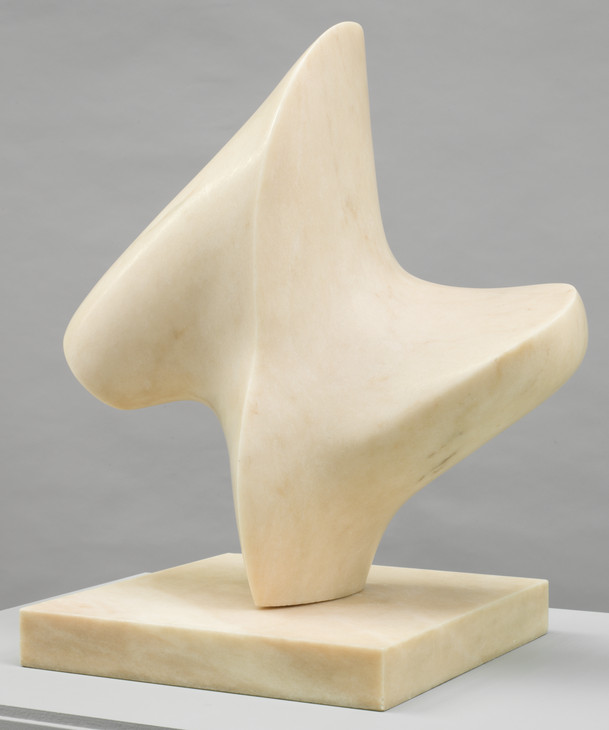
Henry Moore OM, CH 1898–1986
Upright Form: Knife Edge 1966
Marble
overall: 660 x 585 x 410 mm
Tate T01172
Presented by the artist 1970
© The Henry Moore Foundation. All Rights Reserved
Henry Moore OM, CH
Upright Form: Knife Edge 1966
Tate T01172
© The Henry Moore Foundation. All Rights Reserved
1975
In March Moore notifies the Tate Trustees of his intention to donate to the Gallery a set of his prints.11
1978
The list of works to be included in the Henry Moore Gift is finalised in March. Shortly thereafter Moore writes to Reid informing him that he had to reduce the number of works in the Gift from thirty-eight to thirty-six as he had discovered that some of the works reserved for the Gallery belonged to his daughter Mary.12 In compensation his daughter donated two sculptures as part of the gift.
1978
The Henry Moore Gift was exhibited at the Tate Gallery in its entirety, alongside the Tate’s existing holdings of Moore’s sculptures and drawings. Staged between June and August, the exhibition marked the artist’s eightieth birthday. At its close in late August, Reid wrote in a letter to Moore’s daughter Mary that although he was sad to see the exhibition come to an end ‘we have the consolation of the splendid group of sculptures which Henry has presented to the nation’.13
1983
A small exhibition of Moore’s new sculptures, drawings and prints is held at the Tate Gallery over the summer to mark his eighty-fifth birthday.
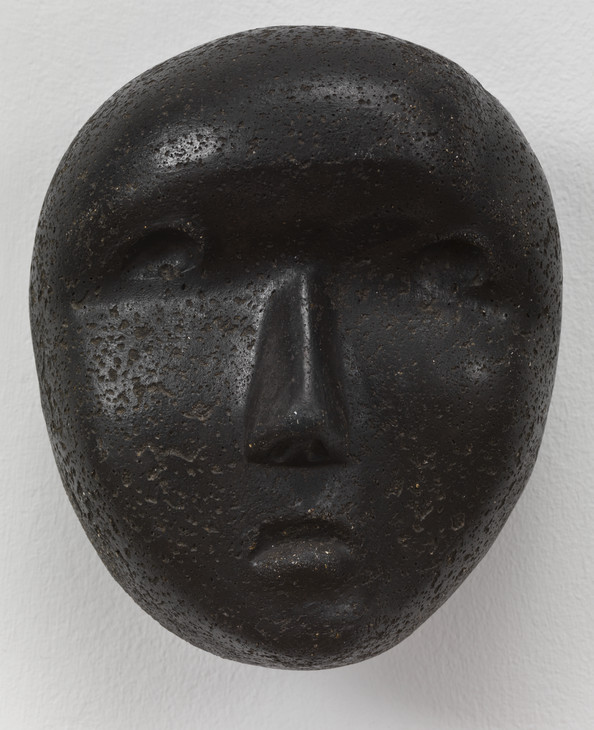
Henry Moore OM, CH 1898–1986
Mask 1929
Cast concrete
object: 200 x 180 x 130 mm
Tate T03762
Transferred from the Victoria & Albert Museum 1983
© The Henry Moore Foundation. All Rights Reserved
Henry Moore OM, CH
Mask 1929
Tate T03762
© The Henry Moore Foundation. All Rights Reserved
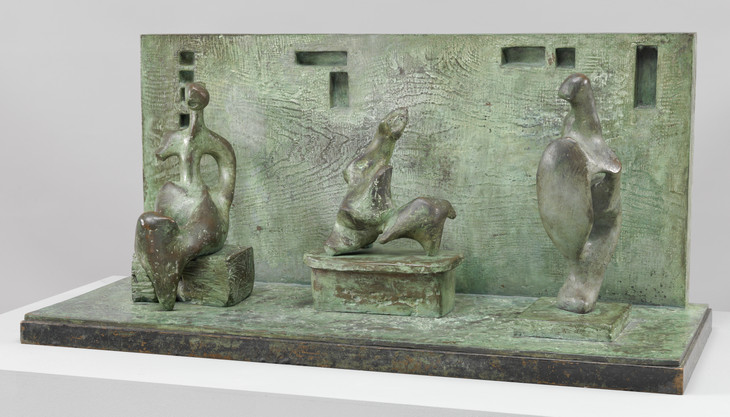
Henry Moore OM, CH 1898–1986
Three Motives Against a Wall No.1 1958, cast 1959
Bronze on copper and wooden base
object: 505 x 1080 x 440 mm
Tate T03763
Transferred from the Victoria & Albert Museum 1983
© The Henry Moore Foundation. All Rights Reserved
Henry Moore OM, CH
Three Motives Against a Wall No.1 1958, cast 1959
Tate T03763
© The Henry Moore Foundation. All Rights Reserved
1983
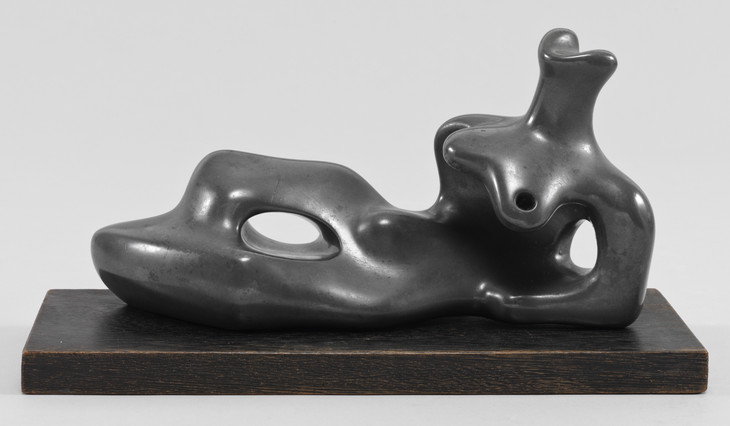
Henry Moore OM, CH 1898–1986
Reclining Figure 1939
Lead on wooden base
overall: 170 x 330 x 134 mm, 10.4 kg
Tate T03761
Transferred from the Victoria & Albert Museum 1983
© The Henry Moore Foundation. All Rights Reserved
Henry Moore OM, CH
Reclining Figure 1939
Tate T03761
© The Henry Moore Foundation. All Rights Reserved
1986
Ninety-seven prints, dating from 1971 to 1984, are donated by the Henry Moore Foundation to the Tate Gallery in February.14
1986
Moore writes to Tate Director Alan Bowness expressing his concern over news reports that public galleries may start charging admission fees. He reminds the gallery that his Gift was made on the understanding that it would be ‘freely’ available to the public.15 He dies at 2 am on 31 August 1986, a month after his eighty-eighth birthday. To mark his death the Gallery displays of four of his sculptures in the entrance rotunda.
2003
Moore’s large scale sculptures are exhibited in the Turbine Hall at Tate Modern. Henry Moore: Public Sculptures is on display between May and August.
2010
Curated by Chris Stephens, Henry Moore, the artist’s third retrospective at Tate, is on display between February and August.16
2013
In May a partly renovated Tate Britain includes galleries designated for the works of Henry Moore. Two displays examine different aspects of Moore’s life and work: his relationship with the Tate Gallery and his sculptural processes.
Notes
Roger Berthoud, The Life of Henry Moore, London 1987, revised edn 2003, p.183. Sainsbury recalled this comment in an interview undertaken by Berthoud in May 1983.
Minutes of a meeting of the Trustees of the Tate Gallery, 16 May 1957, Tate Public Records TG4/2/742/2.
How to cite
Alice Correia, ‘Henry Moore and Tate: A Timeline’, July 2014, in Henry Moore: Sculptural Process and Public Identity, Tate Research Publication, 2015, https://www
